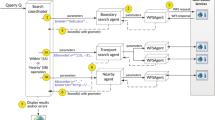Abstract
Geocoding is essential to translating a physical property address such as for a house, business or landmark into spatial coordinates. These coordinates represent geographic location which is an essential ingredient for location-based services and web mapping. Despite progress in the field of geocoding, there remain a sizable proportion of addresses that are difficult to geocode. The purpose of this research was to explore how agent-based processing, which utilizes the belief, desire, intention (BDI) model, can add intelligence to the geocoding process. The event-driven nature of agent-based processing makes it suitable for use in a web service platform. The event-driven and reactive behaviour is complemented by the ability for goal-directed and non-deterministic behaviour. Overall control of the geocoding process is based on the interactions between agents that represent the geographic elements of an address. Each of these agents operates in parallel, pursuing tasks associated with correcting and preparing their individual address element for geocoding. This results in a geocoding process that has multiple foci of control and is iterative. The same geographic relationships that exist between the address elements also exist between the agents. The agents, as geographic elements, communicate via messages that have content relating to their real-world geographic relationships. These relationships form the basis of the inherent semantics in the intelligent framework. An agent-based prototype was developed for intelligent geocoding. Results indicate that intelligence in geocoding is a product of both context and semantics, at a conceptual level, and control and knowledge, at an implementation level.








Similar content being viewed by others
References
Agent Oriented Software (2011) JACK documentation, Agent Oriented Software Group. http://www.agent-software.com/products/jack/documentation_and_instructi/jack_documentation.html. Last accessed 5/06/2011.
Aldemir T (1994) Reliability and safety assessment of dynamic process systems. Springer, Berlin
Berners-Lee T, Hendler J, Lassila O (2001) The semantic web. Sci Am 284:34–43
Cohen WW, Ravikumar P, Fienberg SE (2003) A comparison of string distance metrics for name-matching tasks. In: Eighteenth International Joint Conference on Artificial Intelligence, Acapulco, Mexico
Egenhofer MJ (2002) Toward the semantic geospatial web. In: Proceedings of the Tenth ACM International Symposium on Advances in Geographic Information Systems, McLean, Virginia
Ferber J (1999) Multi-agent systems: an introduction to distributed artificial intelligence. Addison Wesley, New York
Friedman-Hill E (2003) Jess in action: rule based systems in Java. Manning, Greenwich
Goldberg D, Wilson J, Knoblock C (2007) From text to geographic coordinates: the current state of geocoding. Journal of the Urban and Regional Information Systems Association 19(1)
Gu L, Baxter R, Vickers D, Rainsford C (2003) Record linkage: current practice and future directions. Technical report. CSIRO Mathematical and Information Sciences, North Ryde
Howden N, Ronnquist R, Hodgson A, Lucas A (2001) Jack intelligent agents—summary of an agent infrastructure. In: 5th International Conference on Autonomous Agents, Montreal, Canada
Hutchinson M, Veenendaal B (2005a) Towards using intelligence to move from geocoding to geolocating. Proceedings of the 7th Annual GIS in Addressing Conference, Urban and Regional Information Systems Association (URISA), Austin, Texas, August 14–17
Hutchinson M, Veenendaal B (2005b) Towards a framework for intelligent geocoding. In: Proceedings of SSC 2005, Spatial Intelligence, Innovation and Praxis: the national biennial Conference of the Spatial Sciences Institute, September, Melbourne: Spatial Sciences Institute, refereed paper, September 12–16, ISBN 0-9581366-2-9.
Jacquez G, Rommel R (2009) Local indicators of geocoding accuracy (LIGA): theory and application. Int J Heal Geogr 8(1):60
Jennings NR (1993) Commitments and conventions: the foundation of coordination in multi-agent systems. Knowl Eng Rev 8(3):223–250
Jennings NR, Sycara K, Woolridge M (1998) A roadmap of agent research and development. Autonomous Agents and Multi-Agent Systems 1(1):7–38
Karimi H, Durcik M (2004) Evaluation of uncertainties associated with geocoding techniques. Computer-Aided Civil and Infrastructure Engineering 19(3)
Kinny D, Georgeff M, Rao A (1996) A methodology and modelling technique for systems of BDI agents. In: Agents breaking away: Proceedings of the Seventh European Workshop on Modelling Autonomous Agents in a Multi-Agent World (MAAMAW96), pp 56–71
Lee J (2009) GIS-based geocoding methods for area-based addresses and 3D addresses in urban areas. Environment and Planning B: Planning and Design 36(1):86–106
Padgham L, Winikoff M (2004) Developing intelligent agent systems: a practical guide. Wiley, West Sussex
Passin TB (2004) Explorer’s guide to the semantic web. Manning, Greenwich
Shyllon E, Veenendaal B, Hutchinson M (2007) Building knowledge from address information for intelligent geocoding. In: Spatial Sciences Institute International Biennial Conference 2007, Hobart, Tasmania
Wei R, Zhang X, Ding L, Ma H, Li Q (2009) A knowledge based agent prototype for Chinese address geocoding. In: Society of Photo-Optical Instrumentation Engineers (SPIE) Conference Series, Volume 7146 of Presented at the Society of Photo-Optical Instrumentation Engineers (SPIE) Conference.
Wooldridge M (2002) An introduction to multiagent systems. Wiley, Chichester
Zandbergen PA (2008) A comparison of address point, parcel and street geocoding techniques. Computers, Environment and Urban Systems 32(3):214–232
Zobel J, Dart P (1996) Phonetic string matching: lessons from information retrieval. In: SIGIR’96: Proceedings of the 19th annual international ACM SIGIR conference on Research and development in information retrieval, New York, NY, USA, pp 166–172
Author information
Authors and Affiliations
Corresponding author
Rights and permissions
About this article
Cite this article
Hutchinson, M.J., Veenendaal, B. An agent-based framework for intelligent geocoding. Appl Geomat 5, 33–44 (2013). https://doi.org/10.1007/s12518-011-0063-z
Received:
Accepted:
Published:
Issue Date:
DOI: https://doi.org/10.1007/s12518-011-0063-z




